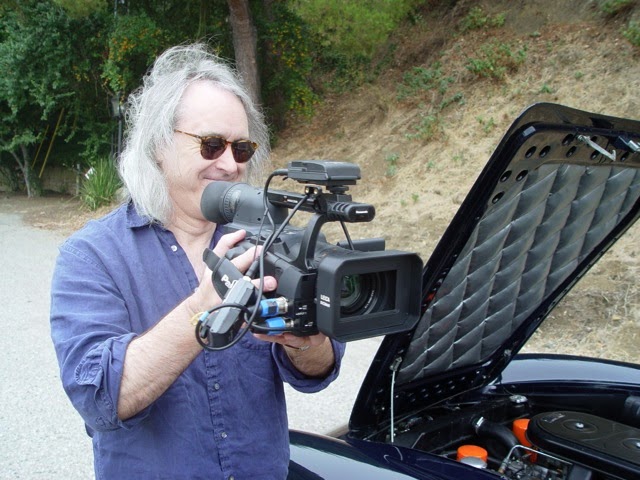
I have had the pleasure of communicating with Gary Barnhill on the subject of Ferraris, Alfa Romeos and a particular Mercedes-Benz 300SL Gullwing that was his along with other things that make life interesting. Gary flew the F-100C as one of the USAFE Skyblazers based on Ramstein Air Base in Germany. With his permission, I am publishing his comments on the release of the AF 447 voice tapes.
"After my comments are the cockpit voice tapes from the beginning of the problem until AF 447 crashed into the sea.
Not all pilots will read this through the same prism of experience.
Pilots with lots of aerobatic experience may read it differently than those who never pursued aerobatics after their initial training.
No airline in the world actually stalls an aircraft in pilot training, not even in the simulator. On a clear day, in daylight, the aircraft may be slowed with the nose slightly up until ONSET OF STALL BUFFET occurs, then the nose is immediately lowered and power added. Piece of cake. Hardly any altitude lost during this practice maneuver. Just don't screw it up and get into a full stall.
This multi-stystems failure occurred in pitch black of night. Apparently in cloud with no visible horizon. The pilots had NOTHING, ABSOLUTELY NOTHING to go on but their instruments, which were giving them false readings. If your airspeed indicator is showing too fast the natural thing to do is pull the nose up, which they apparently did and were totally flummoxed as to why this didn't slow the airspeed.
For the uninitiated, once a plane stalls (gets too slow and is no longer "flying", just falling) the pilot MUST PUT THE NOSE DOWN to gain enough airspeed to no longer be in a stalled condition. Only then can the aircraft nose be raised to avoid further descent.
Stall recovery seems so basic, but I'm not the least critical of those pilots. Their instruments had worse than failed them, their instruments were now lying to them and all their visual clues were also lost in the dark. That is, they could not see the horizon. Did not know up from down.
How about seat of the pants pilot responses? In pitch black with no visible horizon the sole physical indication of up and down is the hairs in a fluid inside your ear. But those hairs get completely fooled when they are pushed up and down plus side forces, which was likely with the a/c pitching and rolling about.
I can't help but wonder if they all were suffering from a huge case of vertigo, which would add to the confusion of spacial orientation. That is; you are right side up and you'd bet your last dollar you are upside down.
As an old aerobatic pilot; while reading the report below the little voice in my head kept saying over and over: put the nose down, put the nose down, put-the-fucking-nose-down. I'm not at all sure, had I been there, I would have put the nose down.
Some incredibly outstanding pilots, perhaps the AF 447 captain was one, might have saved this aircraft from crashing. But a failure of this magnitude must be assigned to the multiple failures that took away everything a pilot knows and is taught about flying and substituted wicked lies which totally overwhelmed the pilots. Who of us has never been overwhelmed? If not, perhaps you simply never got caught up in overwhelming circumstances."
Gary Barnhill
Corona del Mar, CA
Subject: Air France
PARIS (Reuters) - "What do you think? What do you think? What should we do?"
The 37-year-old Air France co-pilot with over 6,000 flying hours was running out of ideas as a stall alarm bellowed through the Airbus cockpit for the sixth time in exactly two minutes.
His junior colleague with two years on the job was already in despair as he battled to control the jet's speed and prevent it rocking left to right in pitch darkness over the Atlantic, on only his second Rio de Janeiro-Paris trip as an A330 pilot.
"I don't have control of the plane. I don't have control of the plane at all," the younger pilot, 32, said.
The captain was not present and it was proving hard to get him back to the cockpit, where his more than 11,000 hours of flying experience were badly needed.
"So is he coming?" the senior co-pilot muttered, according to a transcript released on Friday. Light expletives were edited out of the text here and elsewhere, according to people familiar with the probe into the mid-Atlantic crash on June 1, 2009.
The 58-year-old captain and former demonstration pilot had left 10 minutes earlier for a routine rest. In his absence the plane had begun falling at more than 200 km (125 miles) an hour.
"Hey what are you --," he said on entering the cockpit.
"What's happening? I don't know, I don't know what's happening," replied the senior co-pilot, sitting on the left.
With the benefit of black boxes hauled up 4,000 meters (13,000 feet) from the ocean floor just two months ago, investigators now say the aircraft had stopped flying properly and entered a hazardous stall, as its 3,900 square feet (362 sq meters) of wings gasped for air.
I'VE GOT A PROBLEM
The crew moved control sticks in every direction during their four-minute ordeal -- and sometimes contradicted each other as they tried to save the plane and its 228 passengers and crew. At one point they could not decide whether they were climbing or falling after flying for minutes through a wall of ice particles that blocked the aircraft speed sensors.
In total the stall alarm went off 11 times -- the last of those only overridden by a new and even more ominous direction to "pull up" as the pilots ran out of time and space to recover.
Investigators say they are still baffled as to why the pilots ignored the triple alarm -- a synthetic "stall, stall" voice, a noise like crickets and a red warning light.
They appear to be working on the theory that the pilots recovered clumsily from one problem to do with icing, only to lurch into another one -- a stall -- that proved their doom.
Air France disputes this and says instruments went haywire.
GIVE ME CONTROL
The solution to a stall is to lower the nose to grab air. Instead the junior pilot yanked back, thinking the plane was going too fast.
Pulling up reduces speed. "I've got a problem I don't have vertical speed. I don't have any indication." From behind, the captain was first to voice a dawning truth.
"I don't know but right now we're descending," he said.
Now the young pilot pushed forward and the stall receded.
His gesture lasted barely a second but may be pored over in courts for years as the aircraft's manufacturer Airbus will argue it shows the plane was responsive and able to recover.
Air France says the plane overwhelmed properly trained pilots with a blizzard of confusing signals and misled them because of a "trap" caused by erratic warnings.
The crew have not been officially named.
As the plane hurtled lower, a pattern of professional directions started to fray, replaced by a rush of questions:
"What's the altitude?"
"What do you mean what altitude?"
"Yeah, yeah, yeah, I'm descending right?"
The younger pilot appeared increasingly stressed and was subjected to some backseat driving -- yet he was left to fly.
(Captain) "Get your wings horizontal"
(First co-pilot) "Level your wings"
(Second co-pilot) "That's what I'm trying to do."
Flight 447 entered its final minute at 10,000 feet, having plummeted from 38,000.
"What the -- how is it we are going down like this?" asked the junior pilot.
"See what you can do with the commands up there, the primaries and so on," the senior co-pilot said. By nine thousand feet, the situation must have been dire.
"Climb climb climb climb," ordered the senior co-pilot.
"But I have been pulling back on the stick all the way for a while," observed the younger pilot. In a stall, however, pilots point down to fix the stall first and only then climb to safety.
The captain interjected: "No, no, no, don't climb."
Senior co-pilot: "Ok give me control, give me control."
The plane was at 4,000 feet, its nose up quite sharply.
"Watch out you are pulling up," prodded the captain.
"Am I?" said the first co-pilot.
"Well you should, we are at 4,000," said the young pilot. It is not possible to tell whether the crew finally alighted on what most experts call the right solution, but now they only had one choice, which was to think about avoiding water. Both pilots pulled on their sticks as far as they could.
The computer spoke. "Sink rate. Pull up, pull up, pull up."
"Go on, the captain urged, "pull."
"We're pulling, pulling, pulling, pulling," said number 3.
The transcript showed the three men remained fully focused on trying to right the plane throughout the final four minutes. At no point did they discuss the possibility they and their passengers were about to die.
The last words that could be made out from the veteran captain were remarkably calm, reverting to cool-headed jargon. "Ten degrees pitch," he appears to have said.
Less than half a second later, the recording stopped.
(Editing by Mark Trevelyan)
























































No comments:
Post a Comment